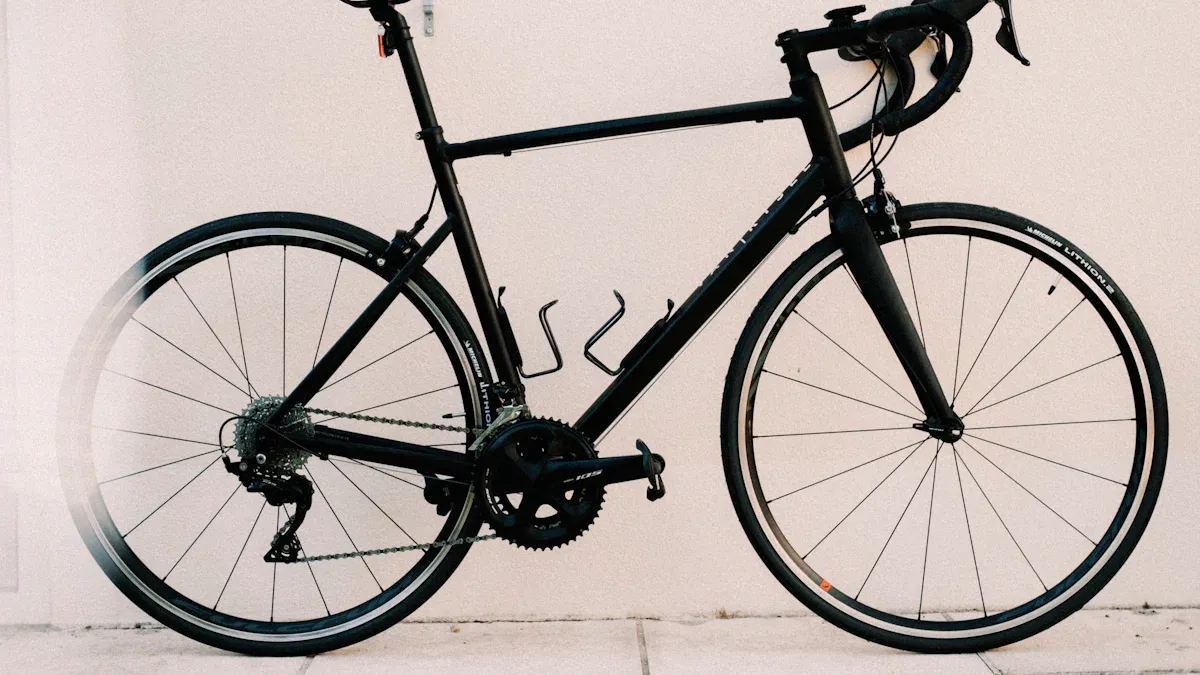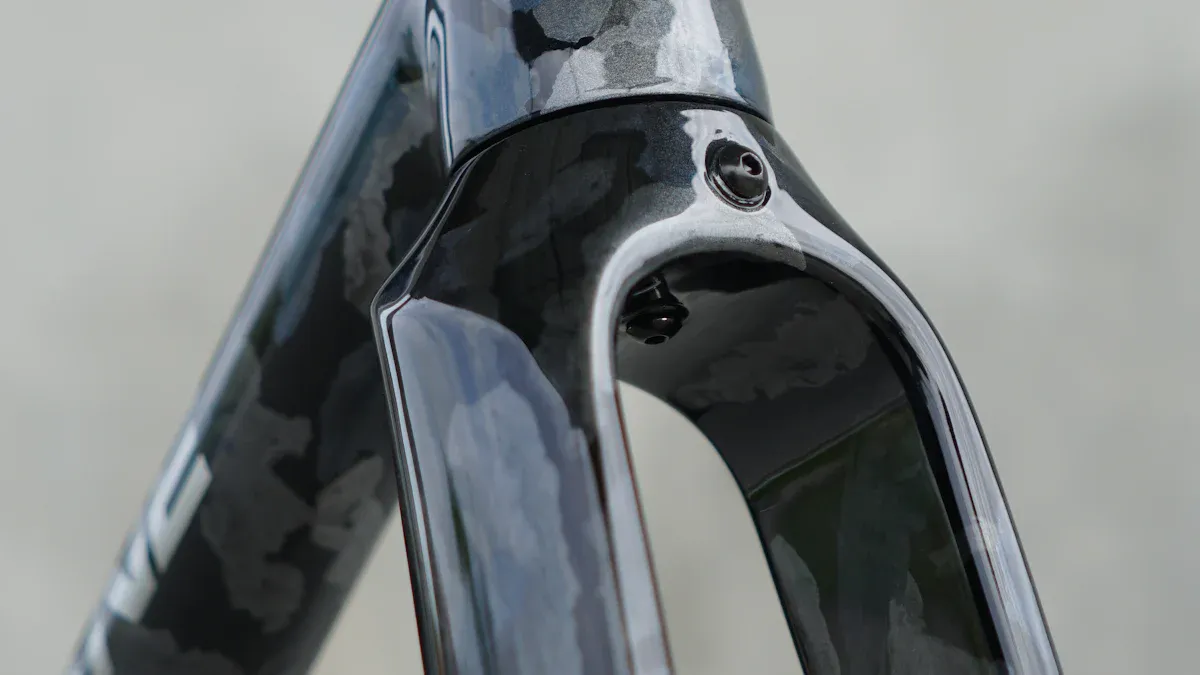
Choosing the right bike frame material in 2025 is very important, especially when considering a road bike frame materials comparison. It can change how you feel while cycling. The material you choose affects your speed and comfort, and it also impacts how much money you spend. For example, lighter frames help you go faster and climb better. Materials like carbon fiber can soak up bumps, providing you with a smoother ride. Each choice in the road bike frame materials comparison has its own cost. Knowing these things will help you decide wisely.
Key Takeaways
Picking the right bike frame material changes your speed, comfort, and budget. Think about how you ride and what you need.
Aluminium frames are light and cheap. They are a good choice for beginners and casual riders.
Steel frames are strong and comfy. They are great for long rides on bumpy roads, but they are usually heavier.
Titanium frames are strong and give a smooth ride. However, they cost more. They are a good investment for the long run.
Carbon fiber frames are the lightest and best for performance. But they can be pricey and need careful handling.
Aluminium Frames

Aluminium Properties
Aluminium is a popular choice for road bike frames. It is light, which helps you climb hills and speed up quickly. Aluminium frames usually weigh less than steel. This can help you perform better. Here are some important facts about aluminium:
Weight: Aluminium frames are lighter than steel frames. This helps you keep speed and move easily on the road.
Tensile Strength: Different types of aluminium have different strengths. For example:
6061 aluminum has a strength of about 38 ksi when heat-treated.
7005 aluminum has a strength of around 42 ksi.
Corrosion Resistance: Aluminium does not rust. It makes a protective layer that keeps it safe from weather. This makes it a strong choice for many conditions.
Pros and Cons
When thinking about aluminium frames, it’s important to look at the pros and cons. Here’s a quick list:
Advantages | Disadvantages |
|---|---|
Weld problems can happen due to flaws | |
Design flaws can weaken welds | |
Flexibility in ride feel | Stiffness changes based on design |
Pros of Aluminium:
Corrosion resistant: You don’t need to worry about rust.
Fast handling: The light weight allows for quick turns.
Highly recyclable: If you upgrade, recycling is good for the environment.
Cons of Aluminium:
Can rust and corrode: While it resists rust, bad care can cause problems.
Stiffness: Some riders may find aluminium frames less comfortable than others.
In terms of cost, aluminium frames are often the cheapest option. They give a good mix of performance and price, especially compared to steel, titanium, and carbon frames. Here’s how they compare:
Aluminum Frames: Light and cheap.
Steel Frames: Heavier and pricier, but very strong.
Titanium Frames: High-end choice with great strength, but very costly.
Carbon Fiber Frames: Light and customizable, but expensive and fragile compared to aluminium and steel.
Choosing the right frame material is important in your road bike frame materials comparison. Aluminium gives a strong mix of performance, strength, and cost, making it a favorite among cyclists.
Steel Frames
Steel Properties
Steel frames are popular with cyclists because they last long and are affordable. If you want a frame that lasts, steel is a great choice. A good steel frame can last for many years, even with regular riding. This strength makes it great for rough roads or trails without breaking.
There are two main types of steel: high-tensile steel and chromoly steel. Each type has special features that can change how you ride.
Pros and Cons
Let’s look at the good and bad sides of steel frames:
Advantages | Disadvantages |
|---|---|
Very durable | Heavier than aluminum and carbon |
Affordable | Can feel less responsive when turning |
Comfortable ride quality | Fewer choices for high-performance bikes |
Pros of Steel:
Durability: Steel frames can take a lot of use, making them great for long-term riding.
Comfort: Steel bends a bit, which helps reduce bumps on the road for a smoother ride.
Cost-Effective: You can usually find good steel frames for less money than titanium or carbon.
Cons of Steel:
Weight: Steel frames are often heavier than aluminum and carbon, which can slow you down.
Less Agile: Some riders think steel frames are not as quick to respond, especially in races.
Now, let’s see how high-tensile and chromoly steel are different:
Chromoly:
Lighter and stronger, giving better performance and speed.
Known for being tough, it balances strength and flexibility, great for tricks.
High-Tensile Steel:
Heavier and not as strong, but offers stability and lasts long, good for beginners.
Strong and durable but not as strong as chromoly.
In the road bike frame materials comparison, steel frames are known for their long life and comfort. If you want a reliable bike that can handle tough conditions, steel might be the best choice for you.
Titanium Frames
Titanium Properties
Titanium frames are special in cycling. They are strong and light. Titanium weighs 4.506 g/cm³. This makes it lighter than steel but heavier than aluminum. You get a strong frame without too much weight.
One great thing about titanium is its ability to resist wear. Unlike other materials, titanium stays strong over time. You can ride hard for years without worrying about your frame getting weak.
Pros and Cons
Let’s look at the good and bad sides of titanium frames:
Pros of Titanium Frames | Cons of Titanium Frames |
|---|---|
High cost because of expensive materials and special making | |
Great at reducing vibrations for a comfy ride | Usually 500g heavier than similar carbon fiber frames |
Completely resists rust, so no paint needed | Hard to fix if damaged because of tricky welding |
Good mix of strength and weight, better power transfer than steel | Quality can change a lot between brands |
Naturally resists hits that could harm other frames | May not feel as quick on climbs compared to carbon |
Titanium frames are known for lasting a long time. They often last longer than the rider, making them a good investment. They don’t rust or chip, so you won’t have to worry about upkeep. But, the price can be a big issue. Titanium frames start around $1,299 for models like the State Bicycle Co. Titanium All-Road Bike and can reach up to $14,850 for custom ones.
In the road bike frame materials comparison, titanium gives a special mix of performance and comfort. But, you need to think about the benefits against the higher cost.
Carbon Frames

Carbon Properties
Carbon fiber frames are very popular with serious cyclists. They are light, which helps improve your performance. In fact, carbon fiber frames are about 30% lighter than aluminum frames. This weight difference can really help when you climb hills or sprint on flat roads.
Here’s a quick look at the average weight of different materials:
Material | Average Weight Comparison |
|---|---|
Carbon Fiber | About 30% lighter than aluminum |
Aluminum | Heavier than carbon fiber but lighter than steel |
Carbon fiber frames usually weigh between 800 grams and 1200 grams. This helps you go faster and climb better. Plus, carbon fiber absorbs bumps from the road better than aluminum. This means you’ll have a smoother ride and feel less tired on long trips.
Pros and Cons
When thinking about carbon frames, you should look at the good and bad sides. Here’s what you need to know:
Weight savings: You’ll notice the difference when climbing or speeding up.
Improved ride comfort: The dampening effects lower vibrations, making your ride nicer.
Superior torsional stiffness: This means better power transfer when you pedal hard.
Cons of Carbon Frames:
Concerns about durability: Some riders worry about how long carbon lasts.
Susceptibility to damage: Carbon can crack or chip if you’re not careful.
Higher costs: Expect to pay more for a carbon frame than for aluminum or steel.
In the road bike frame materials comparison, carbon frames are known for their performance benefits. However, you should think about the higher price and possible durability problems. If you want speed and comfort, carbon might be the best choice for you.
Road Bike Frame Materials Comparison
When you pick a road bike, knowing how different frame materials compare can help you choose the best one. Let’s look at the performance, cost, and comfort of aluminum, steel, titanium, and carbon frames.
Performance Comparison
Performance is very important when you ride. Each material has its good and bad points:
Advantages | Disadvantages | |
|---|---|---|
Aluminum | Strong, light, stiff | Not as strong as steel, rough ride, hard to fix |
Steel | Very strong, lasts long, smooth ride | Heavier than aluminum and carbon |
Titanium | Very strong, great ride, lasts long | Costs a lot, hard to find, tricky to repair |
Carbon | Flexible, light, can be changed for comfort | Costs a lot, can break easily, expensive repairs |
Carbon fiber is great for performance. It absorbs bumps, so you feel less tired on long rides. Its light weight helps you go faster and climb better, making it popular with serious cyclists.
Aluminum frames are heavier but offer good durability and value. They can pass on more road bumps, which might make long rides less comfy.
Steel frames give a smooth ride because they naturally flex. They handle bumps well, making them comfy for long distances.
Titanium has the best features. It’s strong and gives a great ride, but it costs more.
Cost Comparison
Cost matters when you choose a bike frame. Here’s a quick look at how these materials compare:
Aluminum frames are usually the cheapest option. They balance performance and price well, making them popular with many cyclists.
Steel frames are often cheaper than titanium and carbon but can be heavier.
Titanium frames are more expensive. They are a good investment if you want strength and performance, but they can be hard to find.
Carbon frames are usually the most costly. They perform well, but the price can be too high for some riders.
Comfort and Ride Quality
Comfort is very important, especially on long rides. Here’s how each material does in ride quality:
Frame Material | Comfort and Ride Quality Description |
|---|---|
Steel | Gives a smooth ride with natural springiness that absorbs bumps and vibrations, reducing tiredness on long rides. |
Aluminum | Can feel rough on bumpy roads due to its stiffness, sending more road vibrations to the rider. |
Carbon Fiber | Lets you adjust ride quality, mixing stiffness where needed with softness to cushion bumps for comfort. |
Steel frames are very comfy. They soak up shocks and vibrations well, making them a good choice for long rides.
Carbon fiber frames also offer great comfort because they reduce vibrations. They let you change the ride quality, which can make your experience better.
Aluminum frames can feel rough, especially on bumpy roads. But new designs have made them better at reducing vibrations.
Titanium frames give a good mix of strength and comfort, but their higher price can be a downside.
Picking the right material for your road bike frame is very important. Consider how you ride and how much money you want to spend. If you want to go fast, carbon fiber could be the best choice. If you want something strong and comfy, aluminum frames are a good deal. Many cyclists think that just the frame material decides how the bike rides. But really, the design and how it’s made are important too. So, think about your choices carefully and find the frame that works for you! 🚴♂️✨
FAQ
What is the best frame material for beginners?
Aluminum frames are usually the best for beginners. They are light, cheap, and strong. They also give a good mix of performance and comfort, which is great for new cyclists.
How do I choose the right frame material?
Think about how you ride, your budget, and what feels comfy. If you want speed, carbon might be the best. For strength and comfort, steel or titanium could be good choices. Aluminum is a great all-around option.
Are carbon frames worth the cost?
Yes, if you care about performance and being light. Carbon frames are lighter and soak up bumps well. But remember, they can be more expensive and might have some durability issues.
How long do bike frames last?
Bike frames can last many years if you take care of them. Aluminum and steel frames usually last longer than carbon ones. Titanium frames can last a lifetime, making them a smart buy.
Can I repair a damaged frame?
Yes, but it depends on the material. Steel frames are easier to fix. Aluminum and titanium can be harder, while carbon repairs often need a pro. Always ask a specialist for the best advice.
See Also
The Continued Importance of Steel Frame Road Bikes in 2025
Comparing Enduro Bike Frame Materials for Durability and Strength
A Guide to Evaluating Carbon Race Bike Frames for Performance
Understanding Carbon, Aluminum, and Steel Bike Frames for Shoppers
